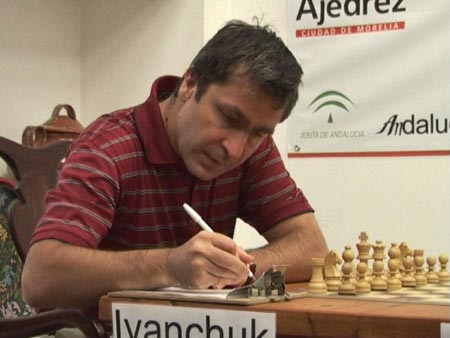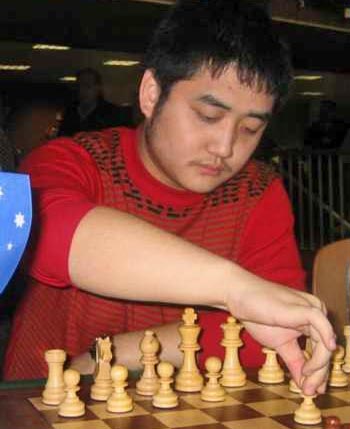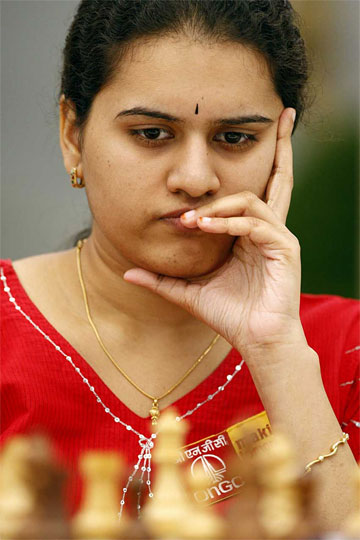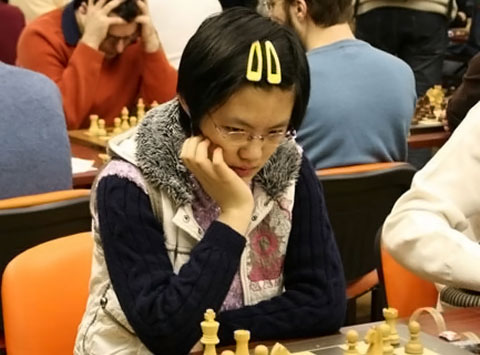| Latest | Greatest | Lobby | Journals | Search | Options | Help | Login |
|
|
|
This topic is archived. |
| Home » Discuss » Topic Forums » Sports |
|
| Jack Rabbit
|
Sun Aug-31-08 12:25 AM Original message |
| The Jack Rabbit Chess Report (August 30): Chuckie wins the Tal; 11 Players Boycott Women's Chmpship |
|
Edited on Sun Aug-31-08 12:41 AM by Jack Rabbit
Chuckie Defeats and Overtakes Moro to Win the Tal
 Ukrainian grandmaster Vassily Ivanchuk defeated reigning Russian national champion Alexander Morozevich in the seventh round of the Mikhail Tal Memorial Tournament to come from behind to win the nine round event that finshed Wednesday. Ivanchuk was also victorious over Hungarian GM Peter Leko in round six to begin his move. After six round, Morozevich was in the lead with 4� points, while Ivanchuk had 2 victories and 4 draws for 4 points. Thus, Ivanchuk's win in round seven put him in the lead, a half point ahead of Morozevich. Chuckie, as he is known to his fans, drew his remaining two games to end the event with 6 points out of nine games: 3 wins, 6 draws and no defeats. Meanwhile, Morozevich dropped his eighth round game to American grandmaster Gata Kamsky to fall further back. Moro took a short draw in the final round and settled for a disappointing second place tie among four players. The other second place finishers were Israeli grandmaster Boris Gelfand, who won only one game but suffered no losses, former world champion Vladimir Kramnik of Russia and Ukrainian GM Ruslan Ponomariov. For the 39-year-old Ivanchuk, the Tal championship is the latest in a year-long run high finishes in elite tournaments which has seen him playing the best chess of his life. Women's Knock Out Championship Begins in Russian Caucasus; 11 Players Boycott  The Knock Out Tournament to name the Women's World Chess Champion began Friday in Nalchik in the north Caucasus Kabardino-Balkaria region of Russia without the eleven women who were invited to attend. The boycott of the event is in reaction to recent Russian invasion of the Republic of Georgia. The six Georgian women who were invited sent a letter to FIDE president Kirsan Ilyumzhinov asking that the event be postponed and relocated for safety. Ilyumzhinov responded by pleading with the women to play in Nalchik, saying that it would be wrong to mix politics and sport. The six Georgians include former women's world champion Maia Chiburdanidze, who became world champion in 1980 at the age of 17 by defeating Nona Gaprindishvili in a match. The others are Lela Javakhishvili, Sopio Gvetadze, Maia Lomineishvili, Sopiko Khukhashvili and Nino Khurtsidze. Kirsan (everybody calls the FIDE president by his first name), in addition to being the president of FIDE, is also the president of the Autonomous Russian Republic of Kalmykia, a post to which he was appointed by then-Russian president Vladimir Putin. The other players who are not participating in the event are Tea Bosboom-Lanchava of Holland, who is a native of Georgia; Irina Krush of the United States, who is a native of Ukraine; grandmaster Marie Sebag of France; Karen Zapata of Peru; and Ekaterina Korbut of Russia. Youth Crush Seniors in Amsterdam A five-member team of Rising Stars defeated a five-member team of experienced grandmasters ranging in ages from 41 to 77 in the annual Youth-Experience Team Match in Amsterdam. The event finished yesterday with the Youth Squad taking 33� out of a possible 50. China's Wang Yue was the leading scorer for the Rising Stars with 8� points out of ten. For this, Wang wins an invitation to next spring's Melody Amber Rapid/Blinfold Tournament in Nice. Calendar Grand Slam Final, Bilbao 2-13 September. Anand-Kramnik World Championship Match, Bonn October 14-November 2. Twelve rounds. European Club Cup, Kallithea (Greece) 16-24 October. Asian Championships, Tehran 21-30 October. Chess Olympiad, Dresden 12-25 November. Topalov-Kamsky World Championship Semifinal Match, Lvov 26 November-15 December. Eight Rounds. FIDE Grand Prix, Doha 13-29 December. |
| Printer Friendly | Permalink | | Top |
| Jack Rabbit
|
Sun Aug-31-08 12:26 AM Response to Original message |
| 1. This week's games |
|
Your humble hare acknowledges the assistance of Fritz 6.0 on analysis. Diagrams on the Jack Rabbit Chess Report are made with Chess M�rida, a true type font that can be downlaoded free here. !""""""""# $tMvWlVmT% $OoOoOoOo% $ + + + +% $+ + + + % $ + + + +% $+ + + + % $pPpPpPpP% $RnBqKbNr% /(((((((() WHITE White to move (This position is a theoretical draw) |
| Printer Friendly | Permalink | | Top |
| Jack Rabbit
|
Sun Aug-31-08 12:28 AM Response to Reply #1 |
| 2. Ivanchuk - Morozevich, Tal Memorial, Round 7, Moscow |
 Vassily Ivanchuk Vassily Ivanchuk - Alexander Morozevich Tal Memorial Tournament, Round 7 Moscow, 25 August 2008 West India Game: Indian Queen's Gambit (Exchange Opening) (Gr�nfeld Defense) 1.c4 Nf6 2.d4 g6 3.Nc3 d5 4.cxd5 Nxd5 5.e4 Nxc3 6.bxc3 Bg7 7.Bc4
7...c5 8.Ne2 0-0 9.0-0 Nc6 10.Be3 Na5
11.Bb5!?
11...Bd7
12.Bd3 b6 13.Rb1 e5
14.dxc5 Ba4?!
15.Qd2?!
15...Qd7
16.cxb6 axb6 17.Nc1 Rfc8?!
!""""""""# $t+t+ +l+% $+ +w+oVo% $ O + +o+% $M + O + % $v+ +p+ +% $+ PbB + % $p+ Q PpP% $+rN +rK % /(((((((() WHITE: Vassily Ivanchuk Position after 17...Rf8c8 18.Rxb6
18...Bf8
19.Ra6!
19...Qb7 20.Rxa8 Qxa8 21.Nb3 Nxb3
22.axb3 Bxb3
23.Rb1!
23...Qa3 24.h3 Be6 25.Rc1 Rd8
26.Qc2 Bb3 27.Qb1 Ba2 28.Qb5 Rc8?
!""""""""# $ +t+ Vl+% $+ + +o+o% $ + + +o+% $+q+ O + % $ + +p+ +% $W PbB +p% $v+ + Pp+% $+ R + K % /(((((((() WHITE: Vassily Ivanchuk Position after 28...Rd8c8 29.Qxe5!
29...Bc5
30.Bxc5!
30...Rxc5 31.Qb8+ Kg7 32.Qf4 Qb2
33.Qe3 f6 34.Bf1
34...Qxc1
35.Qxc5 Qe1 36.Qd4
36...g5 37.c4 Qc1 38.c5 Be6
39.f3 h5 40.Kf2 h4 41.Qe3 Qc2+ 42.Kg1 Bc4
43.Bxc4 Qxc4 44.Kh2 Kf7
45.Qa3 Ke6 46.Qa7 Qc1
47.Qb6+ Kf7 48.Qd6 Qf4+
!""""""""# $ + + + +% $+ + +l+ % $ + Q O +% $+ P + O % $ + +pW O% $+ + +p+p% $ + + +pK% $+ + + + % /(((((((() WHITE: Vassily Ivanchuk Position after 48...Qc1f4+ 49.Qxf4
49...gxf4 50.Kg1 Ke6 51.Kf2 Kd7 52.Ke2 Kc6 53.Kd3 Kxc5 54.Kc3
54...Kd6 55.Kd4 Ke6 56.Kc4 Kd6 57.Kb5 Ke6 58.Kc6 Ke5 59.Kd7 f5 60.exf5 1-0
|
| Printer Friendly | Permalink | | Top |
| Jack Rabbit
|
Sun Aug-31-08 12:29 AM Response to Reply #1 |
| 3. Mamdeyarov - Gelfand Tal Memorial, Round 6, Moscow |
|
Edited on Sun Aug-31-08 12:38 AM by Jack Rabbit
 Boris Gelfand Shakhriyar Mamedyarov - Boris Gelfand Tal Memorial Tournament, Round 6 Moscow, 24 August 2008 Semi-Slav Queen's Gambit: Anti-Meran Gambit (Moscow Defense) 1.d4 d5 2.c4 c6 3.Nc3 Nf6 4.Nf3 e6 5.Bg5 h6 6.Bh4 dxc4 7.e4 g5 8.Bg3 b5 9.Be2
9...Bb7 10.e5
10...Nd5
11.0-0
11...Nd7 12.Nd2 Qb6 13.a4 a6 14.Nde4 0-0-0 15.Bh5!?
15...Nf4!
16.Bxf7
!""""""""# $ +lT V T% $+v+m+b+ % $oWo+o+ O% $+o+ P O % $p+oPnM +% $+ N + B % $ P + PpP% $R +q+rK % /(((((((() WHITE: Shakhriyar Mamedyarov Position after 16.Bh4f7:p 16...Nxe5!
17.Bxe6+ Kb8 18.Ne2?!
18...Bg7 19.Nxf4 gxf4 20.Bxf4 Rxd4 21.a5?
!""""""""# $ L + + T% $+v+ + V % $oWo+b+ O% $PO+ M + % $ +oTnB +% $+ + + + % $ P + PpP% $R +q+rK % /(((((((() WHITE: Shakhriyar Mamedyarov Position after 21.a4a5 21...Qd8!
22.Qe2
22...Re8 23.Rad1 Ka8!
24.Be3 Rxd1 25.Rxd1
!""""""""# $l+ Wt+ +% $+v+ + V % $o+o+v+ O% $Po+ M + % $ +o+m+ +% $+ + B + % $ P +qPpP% $+ +r+ K % /(((((((() WHITE: Shakhriyar Mamedyarov Position after 25.Rf1d1:R 25...Nd3!
26.Bf5 Qd5 27.Qg4 Bxb2 28.h4
28...Bd4
29.Bg6 Rg8 30.Bxd4
30...Qxd4 31.Qe6 Qd5
32.Qe7 c5 33.f3
33...Qd4+ 34.Kh1 Qg7 35.Qxg7 Rxg7 36.h5 b4 37.Kg1 Bxe4 0-1
|
| Printer Friendly | Permalink | | Top |
| Jack Rabbit
|
Sun Aug-31-08 12:31 AM Response to Reply #1 |
| 4. Wang Yue - Agdestein, Team Match, Round 2, Amsterdam |
 Wang Yue Wang Yue - Simen Agdestein Team Match, Round 2 Amsterdam, 21 August 2008 Hollander Game: Kangaroo Defense 1.d4 e6 2.c4 f5 3.Nf3 Nf6 4.Nc3 Bb4
5.Qb3 Qe7
6.Bd2
6...Bxc3
7.Bxc3 d6 8.g3 Nbd7 9.Bg2 Ne4 10.0-0 Nxc3 11.Qxc3 0-0 12.Rfe1
12...e5
13.e4!?
13...f4 14.c5
14...dxc5 15.dxc5
15...Nxc5
16.Rac1 b6 17.b4
17...Na6 18.Nxe5 c5?!
!""""""""# $t+v+ Tl+% $O + W Oo% $mO + + +% $+ O N + % $ P +pO +% $+ Q + P % $p+ + PbP% $+ R R K % /(((((((() WHITE: Wang Yue Position after 18...c7c5 19.b5!?
19...Nc7 20.a4 Be6 21.Nd3
21...fxg3 22.hxg3 Rad8
23.Ne5 Qf6 24.f4 Rd4 25.Ra1 a6?
26.Nc6!
26...Rxe4 27.Qxf6 Rxe1+ 28.Rxe1 Rxf6 !""""""""# $ + + +l+% $+ M + Oo% $oOn+vT +% $+pO + + % $p+ + P +% $+ + + P % $ + + +b+% $+ + R K % /(((((((() WHITE: Wang Yue Position after 28...Rf8f6:Q 29.a5!!
29...Nxb5
30.axb6
30...Nd6
31.Rxe6 Rxe6 32.Bd5 Kf7 33.Nd8+ Ke7 34.Nxe6 c4 35.Bxc4 1-0
|
| Printer Friendly | Permalink | | Top |
| Jack Rabbit
|
Sun Aug-31-08 12:33 AM Response to Reply #1 |
| 5. Stellwagen - Korchnoi, Team Match, Round 6, Amsterdam |
 Viktor Korchnoi Daniel Stellwagen - Viktor Korchnoi Team Match, Round 6 Amsterdam, 26 August 2008 Spanish Grand Royal Game: Gothic Defense (Open Defense) 1.e4 e5 2.Nf3 Nc6 3.Bb5 a6 4.Ba4 Nf6 5.0-0 Nxe4
6.d4 b5 7.Bb3 d5 8.dxe5 Be6 9.Nbd2 Nc5
10.c3 Bg4 11.Re1
11...Nxb3
12.Nxb3 Be7 13.Qd3 Qd7 14.Nfd4 Nxd4!?
15.cxd4
15...a5 16.Qg3 a4 17.Nd2
17...0-0 18.Nf1
18...Ra6 19.Bf4 Rg6 20.Qc3?!
!""""""""# $ + + Tl+% $+ OwVoOo% $ + + +t+% $+o+oP + % $ + P Bv+% $+ Q + + % $pP + PpP% $R + RnK % /(((((((() WHITE: Daniel Stellwagen Position after 20.Qg3c3 20...c5!
21.dxc5 d4 22.Qd2
22...Bxc5 23.Rac1 Bb6 24.Ng3?!
24...Qd5 25.a3 h5
26.h4!
26...Qd8 27.Bg5?!
27...Ba5 28.Qd3 Rxg5!
29.hxg5 Bxe1 30.Rxe1 Qxg5 31.Qxd4 Rd8!
32.Qc3 Rd5 33.Nf1 Qe7?!
34.f4?
!""""""""# $ + + +l+% $+ + WoO % $ + + + +% $+o+tP +o% $o+ + Pv+% $P Q + + % $ P + +p+% $+ + RnK % /(((((((() WHITE: Daniel Stellwagen Position after 34.f2f4 34...Qa7+!
35.Ne3 Rd4 36.g3
36...Qd7 37.Nf1
37...Rc4 38.Qd2
38...Qxd2 39.Nxd2 !""""""""# $ + + +l+% $+ + +oO % $ + + + +% $+o+ P +o% $o+t+ Pv+% $P + + P % $ P N + +% $+ + R K % /(((((((() WHITE: Daniel Stellwagen Position after 39.Nf1d2:Q 39...Rc2!
40.Ne4 Rxb2 41.Re3
41...Rb3 42.Kf2 Be6
43.Re1 Bd5 44.Ng5
44...Rd3 45.f5 f6 46.exf6
46...gxf6 47.Re8+
47...Kg7 48.Ne6+ Kf7 49.Rh8
49...Rf3+ 50.Ke2 Rxf5
51.Nf4 Re5+ 52.Kd2
52...Bf3 53.Rh7+ Kg8 54.Rc7 Rg5 55.Rc8+ Kf7 56.Rc7+ Ke8 57.Rc3
57...Bh1
58.Ke2 Kd7 59.Kf2
59...Bd5 60.Rd3 Kc6 61.Rd2
61...Bc4 62.Rd8 Rg8!
63.Rd1 Rh8 64.Rh1 !""""""""# $ + + + T% $+ + + + % $ +l+ O +% $+o+ + +o% $o+v+ N +% $P + + P % $ + + K +% $+ + + +r% /(((((((() WHITE: Daniel Stellwagen Position after 64.Rd1h1 64...b4!!
65.axb4 Kb5 66.g4
66...h4 67.Nh5 a3
68.Nxf6 a2 69.Ra1 Kxb4 70.Kg2 Kc3 71.Kh3
71...Kb2 72.Rxa2+ Bxa2 73.Nh5 Kc3 74.Kxh4 Be6 0-1
|
| Printer Friendly | Permalink | | Top |
| Jack Rabbit
|
Sun Aug-31-08 12:35 AM Response to Reply #1 |
| 6. Alaa el Din - Koneru, Women's Knock Out, Round 1, Nalchik |
 Koneru Humpy Yorsa Alaa el Din - Koneru Humpy FIDE Knock Out Women's Championship, Round 1/Game 1 Nalchik, 29 August 2008 Bird Game 1.f4 Nf6 2.Nc3 d5 3.Nf3 g6
4.g3 Bg7 5.Bg2 0-0
6.0-0
6...b6!?
7.d3 Bb7
8.Qe1?!
8...d4!
9.Nd1 c5 10.e4 dxe3!?
11.Nxe3
11...e6
12.Qe2
12...Nc6 13.c3 Qc7
14.Bd2?
!""""""""# $t+ + Tl+% $OvW +oVo% $ Om+oMo+% $+ O + + % $ + + P +% $+ PpNnP % $pP Bq+bP% $R + +rK % /(((((((() WHITE: Yorsa Alaa el Din Position after 14.Bc1d2 14...Rad8!
15.Rad1 Rfe8 16.Bc1 Nd5 17.Ng5
17...h6 18.Nf3
18...Nxe3 19.Bxe3 e5 20.Qf2
20...Ba6 21.Qe2 Bb7 22.Qf2 !""""""""# $ + Tt+l+% $OvW +oV % $ Om+ +oO% $+ O O + % $ + + P +% $+ PpBnP % $pP + + P% $+ +r+rK % /(((((((() WHITE: Yorsa Alaa el Din Position after 22.Qe2f2 22...Ba6!
23.Ne1
23...e4!
24.Rd2 exd3 25.Nf3
25...Ne7 26.Re1 Nd5 27.Bf1
!""""""""# $ + Tt+l+% $O W +oV % $vO + +oO% $+ On+ + % $ + + P +% $+ PoBnP % $pP R Q P% $+ + RbK % /(((((((() WHITE: Yorsa Alaa el Din Position after 27.Bg2f1 27...Nf6!
28.Qg2
28...Ng4 29.Bf2 c4 30.Qh3
30...Bc8
31.Qg2 Bb7 32.Qh1
32...Rxe1!
33.Bxe1 Qc5+ 34.Bf2 Nxf2 35.Rxf2 d2 0-1
|
| Printer Friendly | Permalink | | Top |
| Jack Rabbit
|
Sun Aug-31-08 12:37 AM Response to Reply #1 |
| 7. Hou Yifan - Khaled, Women's Knock Out, Round 1, Nalchik |
|
Edited on Sun Aug-31-08 01:34 AM by Jack Rabbit
 Hou Yifan Hou Yifan - Mona Khaled FIDE Knock Out Women's Championship, Round 1/Game 1 Nalchik, 29 August 2008 Spanish Petit Royal Game: Cozio Defense 1.e4 e5 2.Nf3 Nc6 3.Bb5 Nge7
4.Nc3
4...g6
5.d4 exd4 6.Nd5
6...Bg7
7.Bg5 h6 8.Bf6 Bxf6
9.Nxf6+ Kf8 10.0-0 Nf5!?
11.Nd5!?
11...Ng7 12.Bc4
12...Ne6 13.Qd2 b6?!
14.c3 Na5 15.Be2!
15...c6 16.Nf4 dxc3?
!""""""""# $t+vW L T% $O +o+o+ % $ Oo+m+oO% $M + + + % $ + +pN +% $+ O +n+ % $pP QbPpP% $R + +rK % /(((((((() WHITE: Hou Yifan Position after 16...dc3:p 17.Nxe6+!
17...fxe6 18.Qxc3 Kg8
19.Rad1 Qe8
20.Ne5 h5 21.b4 Nb7 22.Rd3 Kh7
23.Rh3 Nd8
!""""""""# $t+vMw+ T% $O +o+ +l% $ Oo+o+o+% $+ + N +o% $ P +p+ +% $+ Q + +r% $p+ +bPpP% $+ + +rK % /(((((((() WHITE: Hou Yifan Position after 23...Nd7b8 24.Nxg6!!
24...Kxg6
25.Rg3+ 1-0
|
| Printer Friendly | Permalink | | Top |
| Jack Rabbit
|
Mon Sep-01-08 11:47 AM Response to Original message |
| 8. Update (Monday): Few upsets in Nalchik's First Round |
|
Edited on Mon Sep-01-08 11:48 AM by Jack Rabbit
The first round has been completed in the FIDE Women's Knock Out Championship in Nalchik, Russia with few surprises.
The biggest upset of round one was the victory of Armenian-American Kat Rohonyan over Ukrainian IM Natalia Zhukova. Ms. Rohonyan won the first Firday game and Zhukova the second Saturday. This lead to the playoff round yesterday, which Ms. Rohonyan won in the rapid phase by drawing the first game (in which she played Black) and winning the second. Some suspense was involved as the when the tie-break between Poland's Monika Socko and Sabina-Francesca Foisor of Romania came down to the Armageddon game with Foisor playing Black, giving her the odds of draw. As she ran out of time with only one Knight each and Kings left on the board, Foisor claimed a draw by insufficient force. However, had Foisor misplayed the position, a checkmate was possible. Mrs. Socko appealed the ruling by the arbiter. The appeals committee ruled in Mrs. Socko's favor. Due to the anti-Russian boycott of the event by some players, two matches ended in double default. These were the matches between Maya Lomineishvili and Sopiko Khukhashvili, both of Georgia, and between Sopio Gvetadze of Georgia and Ekaterina Korbut of Russia. As a result, Koneru Humpy of India and Russia's Alexandra Kosteniuk, both among the favorites to place high in the tournament, advance to the third round by default. In round 4, Koneru will play the winner of the match between Mrs. Socko and Hoang Thanh of Hungary by way of Vietnam while Kosteniuk awaits the winner of the match between her compatriot Tatiana Kosintseva and the reigning US women's champion, Anna Zantonskih. |
| Printer Friendly | Permalink | | Top |
| Jack Rabbit
|
Tue Sep-02-08 10:33 PM Response to Original message |
| 9. Update (Tuesday): Matveeva eliminates reigning champ in Nalchik; Bilbao trmt begins |
|
Nalchik: Reigning Women's Champion Xu eliminated in Second Round
 Xu Yuhua of China, the reigning women's chess champion, was eliminated from the defense of her title in the second round of the FIDE Women's Championship Knock Out by Russian international master Svetlana Matveeva today. Matveeva was a semi-finalist two years ago at the knock out tournament in Ekaterinburg when she was eliminated by Xu. Xu went on to defeat Alisa Galliamova in the final match to claim the title. Matveeva will play Anna Ushenina of Ukraine in the third round beginning Thursday. Tomorrow will be played the second-round tiebreaks in order to resolve matches that ended 1-1 during the last two days. Also advancing to the third round are: 14-year-old Chinese WGM Hou Yifan; Pia Cramling (Sweden); Lilit Mkrtchian (Armenia); Shen Yang (China), who scored a major upset over her compatriot, Zhao Xue; Tatiana Kosintseva (Russia); Ruan Lufei (China); and Hoang Thanh Trang (Hungary). Koneru Humpy of India and Russia's Alexandra Kosteniuk advanced without second-round opposition due to the boycott of 11 players to protest the Russian invasion of Georgia. The most important of tomorrow's tiebreaks will feature former champion Antoaneta Stefanova of Bulgaria against Ju Wenjun of China. Other tiebreaks pit Viktorija Cmilyte (Lithuania) against Nadezhda Kosintseva (Russia); reigning girls' champion Drovavalli Harika (India) against Anna Muzychuk (Slovenia); Nguyen Thi Thanh An (Vietnam) against Elena Sedina (Italy); Inna Gaponenko (Ukraine) against the only surviving American player, Kat Rohonyan of Baltimore. Bilbao Masters begins today  The Bilbao Masters' Tournament, the final leg of the FIDE Grand Slam for 2008, began today in Spain. The other legs of the 2008 grand slam were the Corus A Tournament in Wijk ann Zee, played in January; the Morelia-Linares Tournament in Mexico and Spain in February and March; and the MTel Masters' Tournament in Sofia in May. The participants in Bilbao are: reigning world champion Vishy Anand (India); 17-year-old Magnus Carlsen (Norway); Vassily Ivanchuk (Ukraine); former FIDE world champion Veselin Topalov (Bulgaria); Teimour Radjabov (Azerbaijan); and Levon Aronian (Armenia). The only decisive game in the first round saw Magnus Carlsen, playing Black, defeat Levon Aronian in 51 moves. |
| Printer Friendly | Permalink | | Top |
| nickgutierrez
|
Tue Sep-02-08 10:39 PM Response to Reply #9 |
| 10. I like the Bilbao scoring system. |
|
3-1-0 - that's something I can wrap my head around as a soccer fan, and it rewards players that push for wins. That's important in a big GM tournament like this one.
|
| Printer Friendly | Permalink | | Top |
| Jack Rabbit
|
Tue Sep-02-08 10:59 PM Response to Reply #10 |
| 11. I'd like to watch how that plays out |
|
It might be better than an idea I've kicked around chess discussion boards of just making games won the first tiebreak universally. One still gets the same number of points for two draws on the hand and a win and a loss on the other, but the player with a win and a loss will finish ahead of the one with two draws on tiebreak.
For those who don't know what we're talking about, in Bilbao the winner of a game will be awarded 3 points and each player will be awarded a single point for a draw. |
| Printer Friendly | Permalink | | Top |
| DU
AdBot (1000+ posts) |
Sat May 04th 2024, 04:28 AM Response to Original message |
| Advertisements [?] |
| Top |
| Home » Discuss » Topic Forums » Sports |
|
Powered by DCForum+ Version 1.1 Copyright 1997-2002 DCScripts.com
Software has been extensively modified by the DU administrators
Important Notices: By participating on this discussion board, visitors agree to abide by the rules outlined on our Rules page. Messages posted on the Democratic Underground Discussion Forums are the opinions of the individuals who post them, and do not necessarily represent the opinions of Democratic Underground, LLC.
Home | Discussion Forums | Journals | Store | Donate
About DU | Contact Us | Privacy Policy
Got a message for Democratic Underground? Click here to send us a message.
© 2001 - 2011 Democratic Underground, LLC